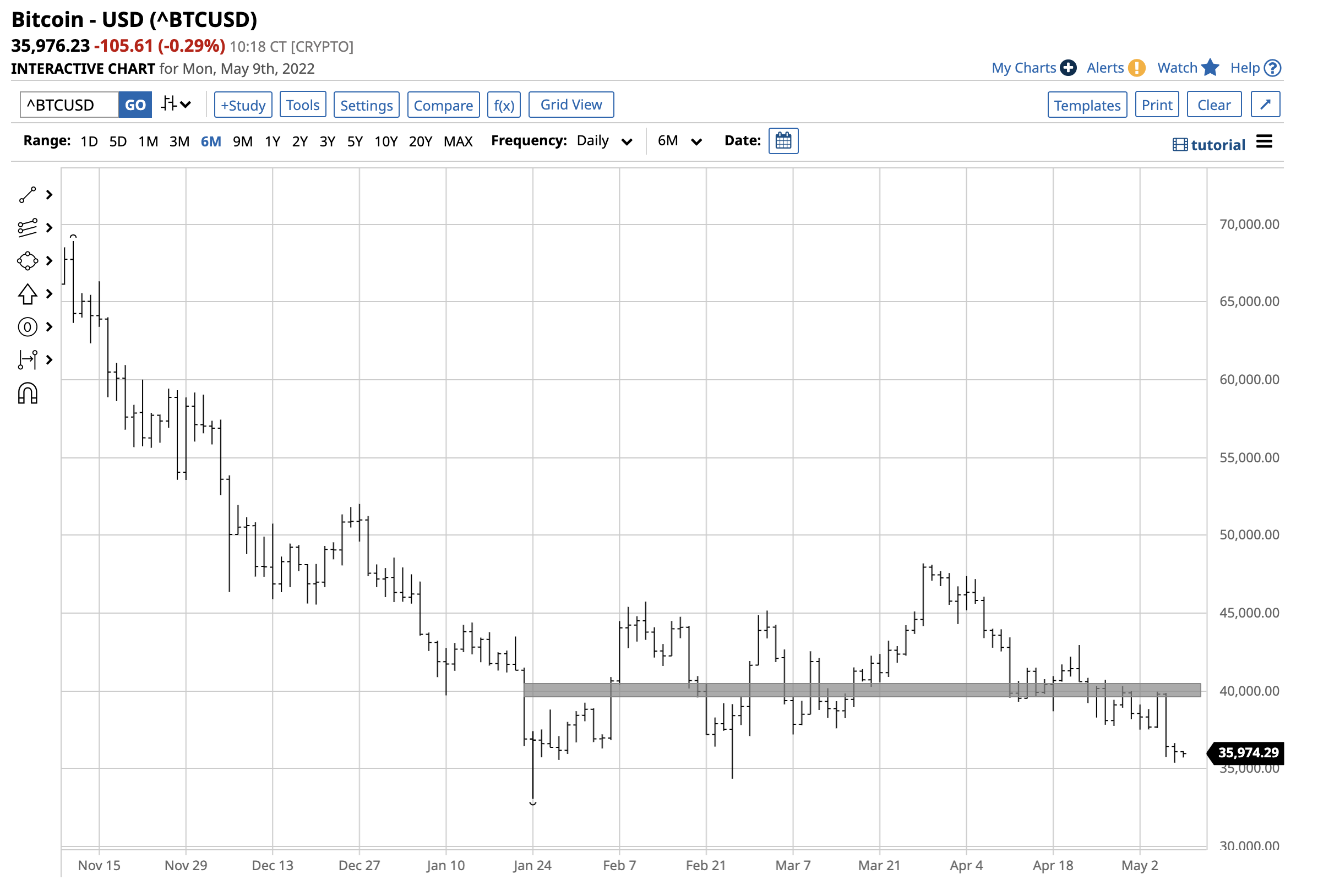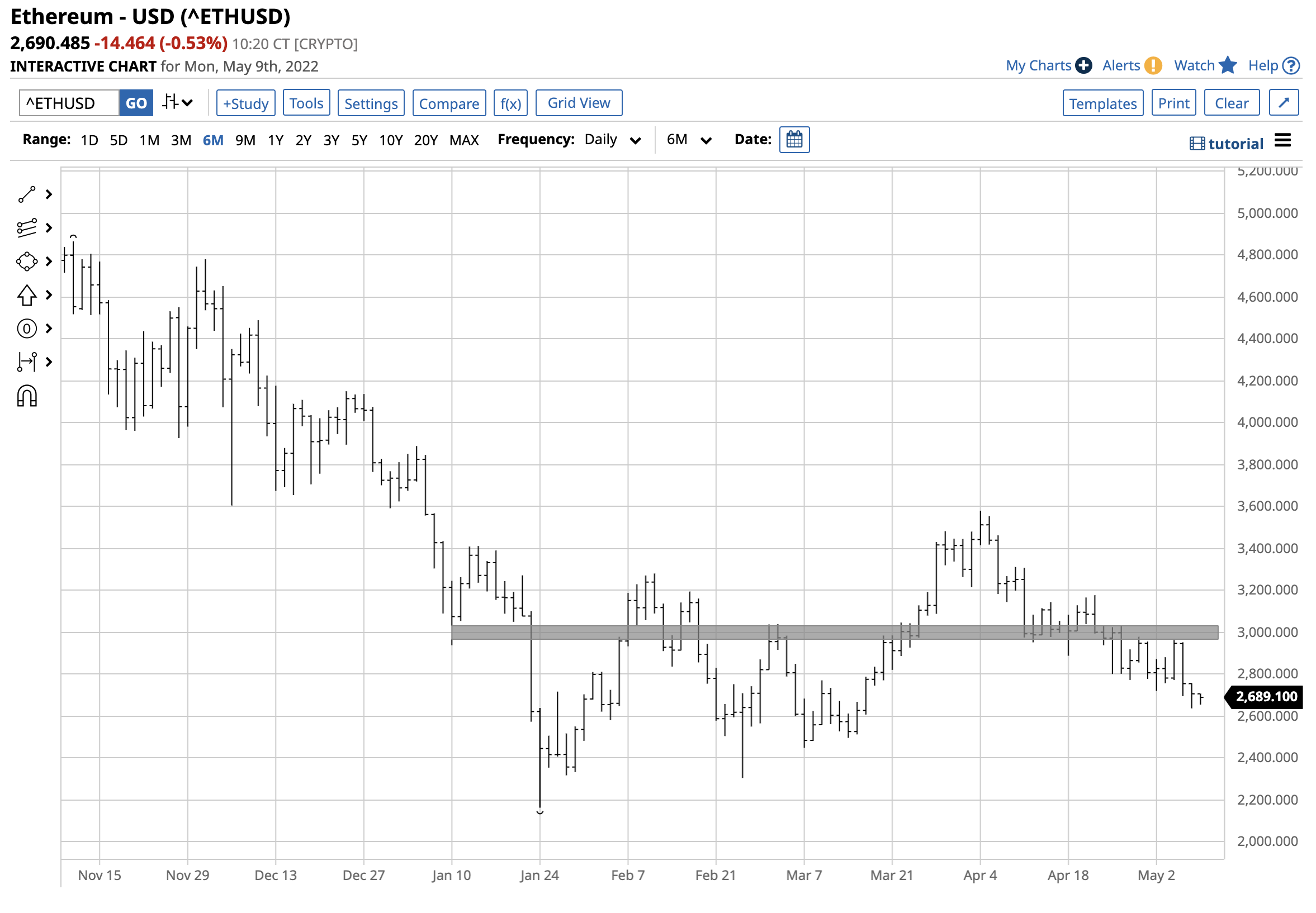This article was written exclusively for Investing.com
- Boring back and forth price action
- Buying feeds on itself
- A mainstream market event
- Government intervention
- A major hack
After correcting from all-time highs on Nov. 10, 2021, Bitcoin and Ethereum reached bottoms on Jan. 24, 2022. Since then, the two leading cryptos have settled into a trading range.
Bitcoin has established $40,000 as a pivot point, while Ethereum has traded on either side of $3,000 per token. While the asset class’s market cap has been around the $1.8 trillion level, the number of new tokens coming to market has steadily increased. As of the end of last week, over 19,200 cryptocurrencies were competing for capital.
After the wild price volatility over the past years, prices have stabilized. Price stability is a sign the asset class is maturing. As liquidity increases, price variance tends to decline.
Still, cryptos have been hibernating. However, potential for another bout of explosive and implosive action could be on the horizon. The recent trading ranges suggest that the top cryptos are tightly coiled springs that will eventually break higher or lower, and wild price swings could return.
Boring back and forth price action
Bitcoin has been trading on either side of $40,000 since late January 2022.

Source: Barchart
As the chart shows, the price has traded from a low of $33,076.69 to a high of $48,187.21, with an average of $40,631.95. While the leading crypto was just below the $36,000 level at the end of last week and is trading currently at $33,565, the $40,000 has been a pivot point where the price has consolidated since the Jan. 24 low.

Source: Barchart
The chart above highlights Ethereum’s range since late January, which has been from $2,163.316 to $3,579.866 per token, with an average of $2,871.591. At time of writing, it's trading at $2,451.42.
While the $3,000 level has been Ethereum’s pivot point, the token has traded on either side of the $3,000 level since reaching the low in late January.
Buying feeds on itself
The spectacular rallies for Bitcoin and Ethereum over the past years fueled a speculative frenzy that came to a crescendo on Nov. 10, 2021. The correction and price consolidation have tempered the market’s enthusiasm with many speculators moving to the sidelines.
A move above the $48,200 level in Bitcoin and $3,600 level in Ethereum would be a technical breakout and could cause buyers to flock back into the cryptocurrency arena. Bullish sentiment would be rocket fuel for the asset class with trend-following speculators returning to cryptocurrencies as buying will encourage more buyers.
But cryptos appear to be waiting for a trigger that would ignite the next rally. Here are 3 possibilities:
1. A mainstream market event
In late 2017, the introduction of Bitcoin futures on the CME pushed the token price to the $20,000 level for the first time. The listing of the Coinbase (NASDAQ:COIN) exchange on NASDAQ in April 2021 pushed prices higher. Events that increase the asset class’s reach and visibility tend to propel prices higher.
Some of the events that could be on the horizon are growing acceptance by retailers and suppliers that accept and encourage payment with cryptocurrencies. High-profile investors like Elon Musk, Jack Dorsey, and other tech moguls have led to higher prices as market participants follow the leaders.
The current weak prices come on the heels of the recent Berkshire Hathaway (NYSE:BRKa) gathering in Omaha, Nebraska. Warren Buffett and Charlie Munger are not fans. Mr. Buffett said he would not pay $25 for all the Bitcoin in the world, and Munger called cryptocurrencies “stupid and evil.”
The comments by these closely followed and highly successful investment managers put a latest dark cloud over the asset class.
2. Government intervention
Mr. Munger’s comment reveals the underlying problem cryptos face. He qualified “evil,” saying, “it undermines the Federal Reserve System.” Governments are no fans of cryptocurrencies as they threaten the control of the money supply, taking it away from the government and returning it to individuals.
Cryptocurrency devotees who embrace the libertarian ideology of the means of exchange agree with Munger but support undermining the Federal Reserve System. Charlie Munger hit the nail on the head, identifying the ideological divide between cryptocurrency supporters and detractors.
On one side, the evolution of the fintech revolution favors cryptos. On the other, traditional financial institutions and governments reject it as it eliminates them from the equation.
Messrs. Buffett and Munger, government officials, and traditional financial companies would likely agree that Blockchain technology is improving efficiency, transaction speed, and record-keeping. However, they would like to cut the tokens themselves, the actual cryptocurrencies, out of the equation.
Munger noted that the leader of the world's second largest economy, Xi Jinping, was “smart enough to ban Bitcoin in China.” Government intervention continues to pose the most significant threat to the asset class.
3. A major hack
The Russian invasion of Ukraine, sanctions, and retaliation, all threaten an expanding economic war with the US and Europe on one side and China and Russia on the other. The ideological bifurcation created by the Chinese-Russian “no-limits” support agreement amounts to an economic struggle between the two sides.
Hacking computer systems is an integral part of modern cyber warfare. The rise of the cryptocurrency asset class makes it a juicy target for hackers looking to pick computer wallets. Russia, China, North Korea, and Iran have been hacking computer systems worldwide for years. Ransomware payments are typically demanded in hard-to-trace cryptos.
Any significant hack of a crypto platform would scare market participants away from the asset class, as occurred in 2014 when the Japanese, Mount Gox exchange went into bankruptcy after losing customers’ 740,000 Bitcoin along with 100,000 the company-owned.
However, in 2014, Bitcoin’s all-time high was over 30 times less than the current price. A hack now would be a substantial blow to the asset class.
Cryptocurrencies are consolidating above the late January low, far under the Nov. 10, 2021, record highs. It appears the asset class is waiting for the next significant event to push cryptos in one direction or the other—to either higher peaks or lower lows.
The longer the consolidation, the more substantial the eventual move will be. Cryptos will undoubtedly move eventually, but the direction will depend on the type and quality of the roadblocks encountered on the path to fintech evolution.
